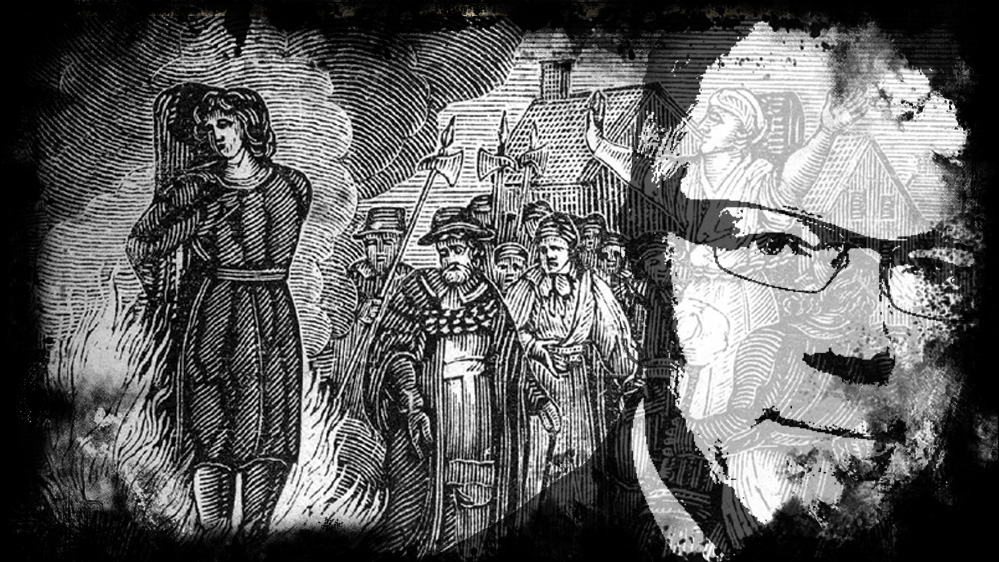
Between 1561 and 1760, about 860 people were put on trial for witchcraft in No(r)way, resulting in about 277 confirmed executions, most of them burnt alive. About 400 years later, lawyer Jostein Løken want to rectify the atrocities done to people accused of black magick and witchcraft.
Jostein is from Elverum, a partner in Advokatfirmaet Elden AS, and has been fascinated by the witch-burning that took place in Elverum in the year 1625.
Ingeborg Knutsdatter Økset, her son and sister were sentenced to death and burned alive for practicing witchcraft.
“Ingeborg was betrayed by her sister and Ingeborg’s son, who both were tortured until they started naming people. All three were subjected to atrocities. It has bothered me and we can’t accept this”, Jostein says
While he’s at it, he should also go after the religion(s) that caused this and other “proud” milestones in human history. All in the name of some over hyped fantasy creature, brought to life by delusional crackpots that “had a vison” on a late Friday night;)
Happy Friday everyone! 😀
Witch trials in Norway
The Witch trials in Norway belonged to the most intense of the Nordic countries. Norway was in a union with Denmark during this period, and the witch trials were conducted by instructions from Copenhagen.
The Norwegian law; Landsloven in the 13th-century stated the death penalty for magic if it resulted in someone’s death or injury, but no execution for sorcery is known in Norway prior to the 16th century and only one witch trial: the one of Ragnhild Tregagås in 1325.
In 1584 King Frederick II of Denmark and Norway, on the recommendation of the Bishop of Stavanger Jørgen Eriksen, who were concerned about the frequent habit of the population’s trust in the services of cunning men and cunning women, introduced the death penalty on the practicing of all sorcery in the Stavanger Bishopric; in 1593, this law was expanded to apply in all of Norway.
The witch trials
Between 1561 and 1760, about 860 people were put on trial for witchcraft in Norway, resulting in about 277 confirmed executions. However, these figures comes from the confirmed cases of which there are documentation and as such represent only a minority, as much documentation is known to be missing. The unconfirmed witch trials are estimated to be at least 1400, resulting in at least 350 executions. The most well documented areas are Finnmark, Rogaland and Hordaland from the 1590s onward.
In investigation could be instigated by the bailiff with reference to public safety after rumors’ of witchcraft had been heard from at least three different households. An accusation from a private citizen often came after a conflict, and was usually death or illness allegedly caused by witchcraft. The authorities and the clergy managed the witch trials after instructions from international demonology handbooks, were Devil’s Pacts and Witches’ Sabbaths were the main definitions of a witch, but in general, the Norwegians did not include such things in their accusations, nor did the accused, who could admit to practicing folk magic voluntarily but did not associate this with Satan. The authorities interrogated the accused by interpreting their testimony so that it could fit in with the witch trial handbook’s definition of what a witch was, and used torture to get a confession about a Devil’s Pacts and a Witches’ Sabbath. Torture prior to a confession was formally illegal in accordance with the Danish torture law of 1547, but was nevertheless commonly used. After a guilty verdict, the condemned was interrogated again, this time to expose accomplices. Death by torture or in prison was common. The method of execution was often burning alive at the stake.
The majority of those accused in Norway were either poor, vagabonds, beggars and other marginalized people; or cunning folk, normally people long rumored to perform sorcery, and 80 percent were women, normally a married woman or a widow. The most profiled victims of the Norwegian witch hunt were Anne Pedersdotter of 1590 and Lisbeth Nypan of 1670.
The end
After the 1670s, witch trials became more and more uncommon in Norway. The reason was that the high courts started to investigate and prevent the legal mistakes often made by the local courts handling the witch trials, such as the use of torture prior to a guilty verdict, the use of condemned criminals as witnesses and trial by ordeal, all of which were technically illegal and all of them commonly used in the witch trials. When witch trials were conducted in accordance with the law after the 1670s, the became smaller and fewer, and the method of execution was also to be decapitation rather than burning.
The Norwegian law of 1687 kept death penalty for witchcraft, and the Witchcraft Act was in fact formally in place until 1842. The last confirmed execution for sorcery in Norway was the execution of Johanne Nilsdatter in 1695. Witch trials did occur in Norway during the 18th-century, but the authorities no longer issued the death penalty in such cases. Because of lacking documentation, some of the witch trials in the 18th-century may theoretically have resulted in death sentences, such as the one against Brita Alvern in 1729.
